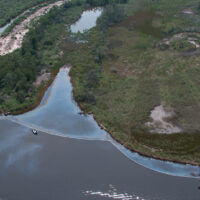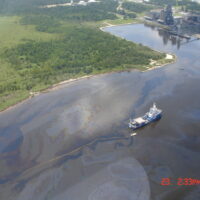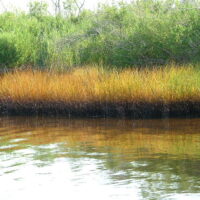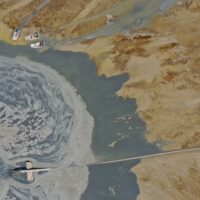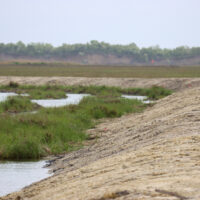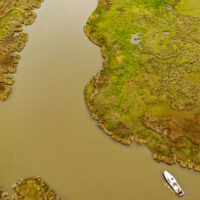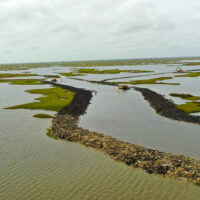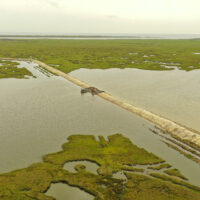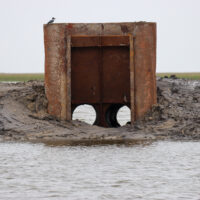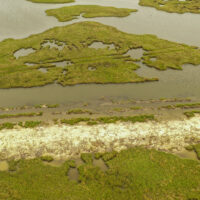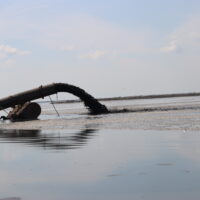BACKGROUND
The Long Point Bayou Marsh Creation Project is situated to the west of the Calcasieu Ship Channel (CSC), between the Gulf of Mexico and Lake Charles. The project is adjacent to the area where more than 155 miles of shoreline were damaged by a 2006 oil spill from the CITGO Lake Charles Manufacturing Complex, located north of the site. The spill released an estimated 2.7 million gallons of oil and oily wastewater into the Indian Marais waterway, which then flowed into the Calcasieu River and nearby wetlands, making it one of the largest and most toxic oil spills in the United States.
- Overflight photo of shoreline sheening and recovery operations. Courtesy of NOAA
- Vessel skimming on Calcasieu River south of Citgo Refinery. Courtesy of NOAA
- Shoreline vegetation stained with dark band of oil. Courtesy LDEQ
Within two weeks of the spill, marsh plants died, and the shoreline began to erode. Intertidal and subtidal sediments were polluted, and fish, birds, and benthic organisms were killed, significantly affecting wildlife and the habitat they rely on.
PROJECT DETAILS
With an estimated cost of $16.7 million, the Long Point Bayou Marsh Creation Project is a great example of how dredged material can be used beneficially for marsh creation. This project is using material dredged from the nearby CSC as part of the U.S. Army Corps of Engineers (USACE) maintenance dredging event. If not used for marsh creation, the dredged material would have to be disposed of in upland disposal areas. Construction of the Long Point Bayou Marsh Creation Project started in December 2022 and is expected to be completed by late 2023. Once completed, the project will create approximately 395 acres of new marsh.
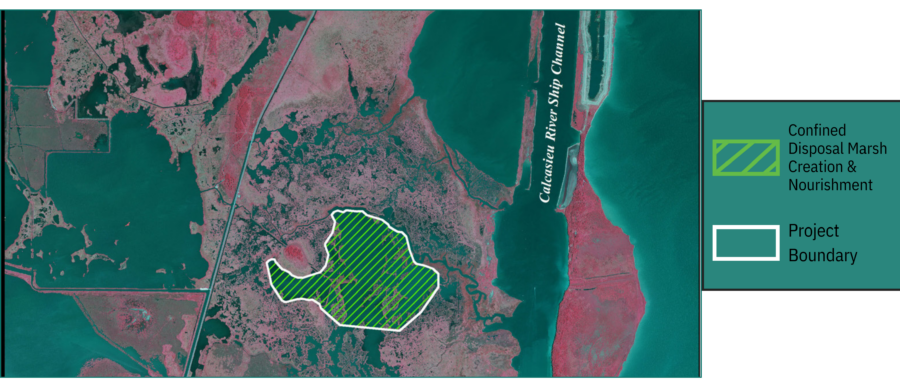
The project will also re-establish a part of the historic Long Point Bayou channel and create tidal creeks to provide tidal exchange into and out of the marsh creation area. Additionally, constructing tidal creeks will increase the marsh edge habitat, which is a highly productive transition zone between the vegetated interior of the marsh and the fluctuating intertidal zone.
This edge habitat is especially important to two vulnerable species, the saltmarsh topminnow (Fundulus jenkinsi) and the black rail (Laterallus jamaicensis jamaicensis).
The new marsh created by this project will also provide vital habitat for a variety of organisms, including red drum, brown and white shrimp, pelicans, gulls, rails, and migrating waterfowl.
Partners and Funding
This project is a unique partnership between the Louisiana Oil Spill Coordinator’s Office, the Louisiana Department of Environmental Quality, the Louisiana Department of Natural Resources, the Louisiana Department of Wildlife and Fisheries, the Coastal Protection and Restoration Authority, the U.S. Department of the Interior, represented by the United States Fish and Wildlife Service, and the United States Department of Commerce, represented by the National Oceanic and Atmospheric Administration, collectively known as the Natural Resource Trustees, and the USACE and the U.S. Environmental Protection Agency (EPA).
The project is being constructed by the USACE as part of their maintenance dredging event for the lower CSC. The design phase of the project was funded through the Louisiana Coastal Wetlands Planning, Protection and Restoration Act. The Natural Resource Trustees are funding the construction of the project as part of the 2006 CITGO Calcasieu River case settlement.
To download a photograph of the project below, click on a photograph and then right-click “save as.”

